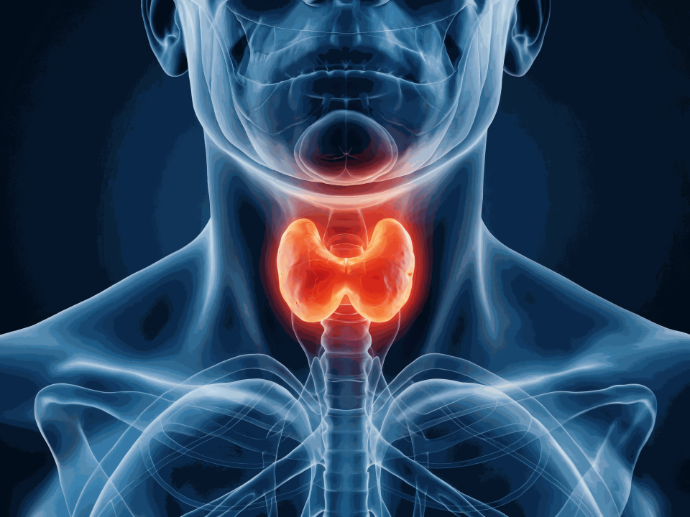
Protect Your Thyroid Campaign
A Literature Review:
Thyroid Health Risks in Healthcare Professionals: Incidence, Prevalence, and Awareness.
Thyroid Health Risks in Healthcare Professionals: Incidence, Prevalence, and Awareness
Incidence and Prevalence of Thyroid Problems among Healthcare Workers
Multiple studies (spanning different countries and time periods) have examined how common thyroid disorders are among healthcare professionals.
Elevated Thyroid Dysfunction in Radiation-Exposed Staff:
Elevated Thyroid Dysfunction in Radiation-Exposed Staff: Medical staff who work in radiation-prone departments (e.g. radiology or radiotherapy) show higher rates of thyroid abnormalities.
A 2023 study of 484 radiotherapy department workers found that 30.4% had abnormal thyroid function – a markedly high detection rate. This was significantly above the ~6.6% rate observed in general populations of Europe/US and even higher than the ~25% prevalence in community-dwelling seniors (65+) in the US. (By comparison, a similar study of radiologists in Nanjing, China reported an even higher positive rate of 39.4%.) The 2023 study noted several risk factors contributing to thyroid dysfunction in these workers, including occupational radiation exposure, longer years of service, older age, smoking, late-night snacking, high stress, and depression , whereas regular exercise was protective. In fact, staff with chronic low-dose radiation exposure had about 2.4 times higher odds of thyroid dysfunction than non-exposed staff. These findings underscore that healthcare professionals in radiation-heavy fields face a non-trivial risk of thyroid problems and that this risk accumulates with prolonged exposure.
Ren et al. (2023) – Frontiers in Public Health : Study of 484 radiotherapy staff in China
Thyroid Nodules and Cancer in Nurses vs General Population:
A large occupational study in Korea compared female hospital nurses to women from the general public undergoing check-ups.
It found thyroid nodules in roughly one-third of nurses (30.8%), which was actually slightly lower than the prevalence in the general female group (38.9%). Importantly, the rate of thyroid cancer diagnosed was very similar between nurses and controls (about 1.6% of nurses vs 1.4% of other women). The difference was not statistically significant, leading the authors to conclude that working in a hospital did not appreciably increase the prevalence of thyroid nodules or thyroid cancer in that cohort. This suggests that not all healthcare professionals have higher thyroid risk; factors like the specific role and exposure type matter. Nurses, who may have relatively limited radiation exposure, did not show excess risk in this study.
Woo et al. (2016) –
Clin Exp Otorhinolaryngol
: Occupational study in Korean nurses
Impact of Occupational Radiation – Autoimmune Thyroid Disease:
Research has linked on-the-job radiation exposure to autoimmune thyroid issues.
In a population-based study from Germany, female healthcare workers with a history of occupational ionizing radiation exposure had about three times the rate of autoimmune thyroid disease (AITD) compared to non-exposed females (10.0% vs 3.4%). Even after controlling for confounders, the association held with an odds ratio ~3.5 for AITD in exposed women. (The sample of exposed men was too small to draw firm conclusions, though a similar trend of increased thyroid hypo-echogenicity was noted.) Notably, those with >5 years of exposure had the highest risk. The authors concluded that occupational radiation is indeed related to higher thyroid autoimmunity risk and strongly recommended consistent use of thyroid shielding for radiation workers . This finding aligns with the notion that cumulative low-dose radiation can trigger thyroid damage or autoimmunity over time, reinforcing the need for protective measures in medical settings.
Völzke et al. (2005) –
J. Clin. Endocrinol. Metab.
: Population study (Pomerania, Germany) linking occupational ionizing radiation to autoimmune thyroiditis
Higher Thyroid Disease Risk in Healthcare Professionals:
Some epidemiological data suggest healthcare professionals in general may face higher thyroid disease rates than the public.
For example, an analysis reported that physicians had significantly higher risks of developing thyroid disorders (including hypothyroidism and thyroid cancer) compared to the general population (academic.oup.com). Similarly, a case-control study in Connecticut observed that people in healthcare occupations had elevated odds of thyroid cancer. In that study, “health diagnosing and treating practitioners” (a category including physicians, surgeons, dentists, pharmacists, etc.) had about 1.8 times higher odds of papillary thyroid cancer than those in other jobs (pmc.ncbi.nlm.nih.gov.) Working as a registered nurse was also associated with increased thyroid cancer risk, particularly for those with longer than 10 years in the job (pmc.ncbi.nlm.nih.gov.) These findings, while not universal, indicate that certain occupational stresses or exposures in the medical field (radiation being a prime factor, but possibly also stress or irregular schedules) can contribute to higher incidence of thyroid conditions among healthcare workers.
Indeed, other surveys have estimated the overall prevalence of thyroid function abnormalities among medical staff to range roughly 4% to 30% across various studies, with an upward trend in recent years. Even though the range is broad (reflecting different study populations and definitions), the upper end of this range is well above thyroid disorder rates in the general population, highlighting a potential occupational health concern.
QJM (2017) – Commentary on physician health: noted physicians have significantly higher rates of thyroid cancer and hypothyroidism than the general population academic.oup.com, suggesting occupational factors and stress may play a role.
Arrange a training in your department
Get in touch to arrange a training in you department that covers all aspects of radiation protection awareness Including the importance of protecting the thyroid.

Pour installer cette Web App dans votre iPhone/iPad, appuyez sur ![]() et ensuite Ajouter à l'écran d'accueil.
et ensuite Ajouter à l'écran d'accueil.

